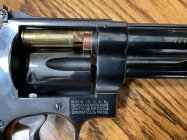Jackie, thanks, that's very informative. The reason I ask: I watched one of Chris Baker's videos over at LuckyGunner, which looked into "Does handgun recoil begin before the bullet leaves the barrel?"
The video (below) uses a high-speed motion camera to observe whether the gun moves before the bullet exits the bore. In two different autoloaders, there is no observed recoil before bullet exit. In a 357 revolver, recoil
always starts before bullet exit.
My theory as to why: Well before exiting the revolver barrel, the bullet exits the case mouth. Significant gases are vented from the cylinder gap as the bullet leaves the case. Just as a bullet (and gases) exiting a barrel creates a recoil impetus, so does a bullet exiting the
case. Only a portion of the gases escape through the narrow cylinder gap, as a lot of it is seen escaping the muzzle behind the bullet as well. Nevertheless, the slow motion video shows clearly that the revolver recoils as soon as gas escapes the case through the cylinder gap.
And why not? Think about an old "pepperbox" revolver like the Allen, which had a rotating cylinder/barrel, like a Gatling gun. If you took a modern revolver and removed the barrel from the frame, you'd be left with something similar. Obviously firing bullets from just the remaining cylinder holes will create significant recoil. But in a regular revolver, the bullet soon engages the forcing cone and bore, which it seems to me would decelerate the bullet and start to dampen the initial recoil. Too complicated for me to analyze, and beyond the scope of this post.
Am I far wrong in my reasoning for why a revolver recoils before the bullet leaves the barrel?
-











